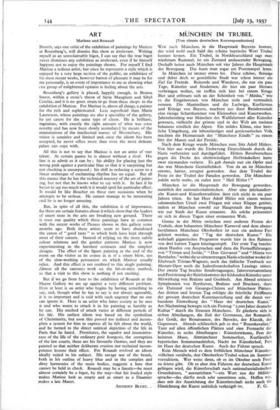ART
Matisse and Rouault BIGOTS, says one critic of the exhibition of paintings by Matisse at Rosenberg's, will dismiss this show as irrelevant.. Writing myself as an unreclaimable bigot, I can say that the true bigot never dismisses any exhibition as irrelevant, even if he himself happens not to enjoy the paintings shown. For myself I find Matisse a tedious artist, but since he represents a style which is enjoyed by a very large section of the public, an exhibition of his most recent works, however barren of pleasure it may be for me personally, is an event of importance to me as showing what one group of enlightened opinion is feeling about the arts.
Rosenberg's gallery is placed, happily enough, in Bruton Street, within a stone's throw of .Syrie Maugham and Sibyl Colefax, and it is no great strain td go from these shops to the exhibition of Matisse. For Matisse is, above all things, a painter for the rich and sophisticated. Less superficial than Marie Laurencin, whose paintings are also a speciality of the gallery, he yet caters for the same type of client. He is brilliant, ingenious, with exactly the right amount of what was once novelty and has now been slowly assimilated by means of the ministrations of the intellectual nurses of Bloomsbury. His vision is sensitive and limited and, once the idiom has been accepted, he never offers more than even the most delicate palate can cope with.
All this is not to say that Matisse is not an artist of vast talent. At certain games he is almost without a rival. His line is as adroit as it can be ; his ability for placing just the wrong pink against a particular blue so that it is surprising but not shocking is unsurpassed ; his skill in reducing a scene to a linear arabesque of enchanting rhythm has no equal. But all this means that he has the technical mastery of the art of paint- ing, but not that he knows what to say with it. In fact if he bePan to say too much with it it would spoil his particular effect. It would be like Boucher on those rare occasions when he attempts to be serious. He cannot manage to be interesting and he is no longer amusing.
But, in spite of all this, the exhibition is of importance, for there are certain features about it which show that the leaders of smart taste in the arts are breaking new ground. There is even one quality which these paintings have in common with the recent works of Picasso shown in this gallery some months ago. Both these artists seem to have abandoned the canon of " good taste " to which both have kept through most of their careers. Instead of relying on the more subtle colour relations and the gentler patterns Matisse is now experimenting in the harshest contrasts and the simplest designs. The effect of the figure painting at the end of the room on the visitor as he comes in is of a smart blow, not of the slow-working persuasion on which Matisse usually relies. And this effect is not confined to this single painting. Almost all the canvases work on the hit-or-miss method, so that a visit to this show is nothing if not exciting.
But if we go from here to the exhibition of Rouault at the Mayor Gallery we are up against a very different problem. Here at least is an artist who begins by having something to say, and, though what he has to say is not always agreeable, it is so important and is said with such urgency that no one can ignore it. Here is an artist who hates society as he sees it and who wants to attack it in his painting as harshly as he can. His method of attack varies at different periods of his life. His earliest idiom was based on the symbolism of Christianity, but soon this proved too indirect and incom- plete a system for him to express all he felt about the world, and he turned to the direct satirical depiction of the life in Paris that he hated. Prostitutes, the squalor and insensitive- ness of the life of the ordinary petit bourgeois, the corruption of the law courts, these are his favourite themes, and they are painted so that neither deliberate evasion nor technical incom- petence lessens their effect. For Rouault evolved an idiom ideally suited to his subject. His savage use of the brush, both in his outline of heavy blue and in the complex and dirty harmonies of the main bodies, suggests a hate that cannot be held in check. Rouault may be a fanatic—he must almost certainly be a bigot, by the way—but his loaded style makes Matisse look as empty and as smart as a Daumier makes a late Manet.
ANTHONY Blum. .






























































 Previous page
Previous page